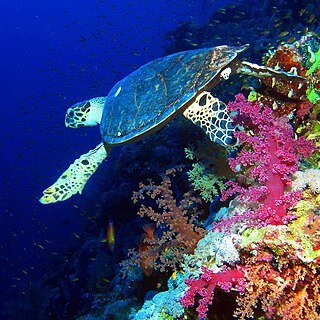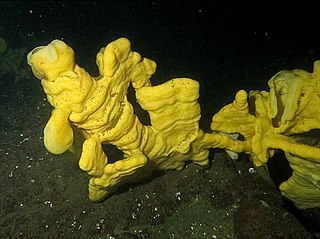
Archaeocyatha is a taxon of extinct, sessile, reef-building marine organisms of warm tropical and subtropical waters that lived during the early (lower) Cambrian Period. It is believed that the centre of the Archaeocyatha origin are now located in East Siberia, where they are first known from the beginning of the Tommotian Age of the Cambrian, 525 million years ago (mya). In other regions of the world, they appeared much later, during the Atdabanian, and quickly diversified into over a hundred families. They became the planet's very first reef-building animals and are an index fossil for the Lower Cambrian worldwide.

Hexactinellid sponges are sponges with a skeleton made of four- and/or six-pointed siliceous spicules, often referred to as glass sponges. They are usually classified along with other sponges in the phylum Porifera, but some researchers consider them sufficiently distinct to deserve their own phylum, Symplasma.

A coral reef is an underwater ecosystem characterized by reef-building corals. Reefs are formed of colonies of coral polyps held together by calcium carbonate. Most coral reefs are built from stony corals, whose polyps cluster in groups.

Marine angelfish are perciform fish of the family Pomacanthidae. They are found on shallow reefs in the tropical Atlantic, Indian, and mostly western Pacific Oceans. The family contains seven genera and about 86 species. They should not be confused with the freshwater angelfish, tropical cichlids of the Amazon Basin.

A reef is a bar of rock, sand, coral or similar material, lying beneath the surface of water.
Many reefs result from abiotic processes, but the best known reefs are the coral reefs of tropical waters developed through biotic processes dominated by corals and coralline algae.

Hecate Strait is a wide but shallow strait between Haida Gwaii and the mainland of British Columbia, Canada. It merges with Queen Charlotte Sound to the south and Dixon Entrance to the north. About 87 miles (140 km) wide at its southern end, Hecate Strait narrows in the north to about 30 miles (48 km). It is about 160 miles (260 km) in length.

Margaret Wertheim is a science writer and the author of books on the cultural history of physics. Margaret Wertheim and her twin sister, Christine Wertheim, live in Los Angeles, California together where they founded and continue to operate the Institute for Figuring (IFF). The Institute for Figuring is a non-profit organization which houses their Crochet Coral Reef, which began as a response to the hyperbolic crocheting abilities of Dr. Daina Taimina, a Cornell University mathematician. Wertheim also creates exhibitions at the intersection of science and art which are shown around the world. She has won the 2016 Klopsteg Memorial Award from the American Association of Physics Teachers, and Australia's Scientia Medal (2017) for her work with public science engagement.

A spongivore is an animal anatomically and physiologically adapted to eating animals of the phylum Porifera, commonly called sea sponges, for the main component of its diet. As a result of their diet, spongivore animals like the hawksbill turtle have developed sharp, narrow bird-like beak that allows them to reach within crevices on the reef to obtain sponges.

Agelas clathrodes, also known as the orange elephant ear sponge, is a species of demosponge. It lives on reefs in the Caribbean, usually more than 10 metres (33 ft) below the surface of the ocean. It takes various forms, and its color is reddish orange.

The giant barrel sponge is the largest species of sponge found growing on Caribbean coral reefs. It is common at depths greater than 10 metres (33 ft) down to 120 metres (390 ft) and can reach a diameter of 1.8 metres. It is typically brownish-red to brownish-gray in color, with a hard or stony texture. The giant barrel sponge has been called the "redwood of the reef" because of its size and estimated lifespan of hundreds to a thousand or more years. It is perhaps the best-studied species of sponge in the sea; a population on Conch Reef, in the Florida Keys, has been monitored and studied since 1997.

Cloud sponge (Aphrocallistes vastus) is a primitive organism of the order Hexactinosida in the class Hexactinellida. It is a deep-water reef-forming animal. The species was first described by F.E. Schulze in 1886.

The Coral Sea Reserves Ramsar Site comprises the 17,292 km2 of oceanic island and reef habitats within the former Coringa-Herald National Nature Reserve and the former Lihou Reef National Nature Reserve in the Australian Coral Sea Islands Territory.

Amphimedon queenslandica is a sponge native to the Great Barrier Reef. Its genome has been sequenced. It has been the subject of various studies on the evolution of metazoan development.

The Upper and Lower Grassi Lakes lie at an elevation of about 1,525 m (5,003 ft) in the southern Canadian Rockies overlooking the town of Canmore, Alberta. They receive their water from the Spray Lakes Reservoir on the Spray River. The land is part of the Canmore Nordic Centre Provincial Park, which is part of the Kananaskis Country park system.

Paleontology in Wisconsin refers to paleontological research occurring within or conducted by people from the U.S. state of Wisconsin. Wisconsin has a relatively sparse fossil record. Fossils found in Wisconsin are generally very old, most ranging from 500 to 300 million years in age.
During the early part of the Paleozoic era, Wisconsin was covered by a warm, shallow sea that would be home to creatures like brachiopods, bryozoans, cephalopods, corals, crinoids, and trilobites. During the Silurian, Wisconsin was home to massive reef system that formed one of the most biodiverse habitats in all of North America at the time. The interval spanning the Permian, Mesozoic, Paleogene and Neogene are missing from the local rock record. During the Ice Age the local climate became cold. Seals, walruses, and whales left behind fossil remains in the state near the Great Lakes. On land, hemlock and spruce trees formed forests inhabited by creatures like giant beavers, horses, and woolly mammoths. The first fossil reef systems ever scientifically documented in North America were discovered in the area around Milwaukee. The Silurian reefs of the Milwaukee area were also the first known fossil reefs from the Paleozoic era. Their associated fauna is one of the most diverse from the period ever documented in North America. The Ordovician to Silurian trilobite Calymene celebra is the Wisconsin state fossil.

The Amazon Reef, or Amazonian Reef, is an extensive coral and sponge reef system, located in the Atlantic Ocean off the coast of French Guiana and northern Brazil. It is one of the largest known reef systems in the world, with scientists estimating its length at over 1,000 kilometres, and its area as over 9,300 km2 (3,600 sq mi). Publication of its discovery was released in April 2016, following an oceanographic study of the region in 2012. Evidence of a large structure near the delta of the Amazon River dated from as early as the 1950s.

Joseph Richard Pawlik is a marine biologist. He is the Frank Hawkins Kenan Distinguished Professor of Marine Biology in the Department of Biology and Marine Biology at the University of North Carolina Wilmington. He is best known for studies of sponges on Caribbean coral reefs that reveal ecological principles such as resource trade-offs, trophic cascades and indirect effects.


















